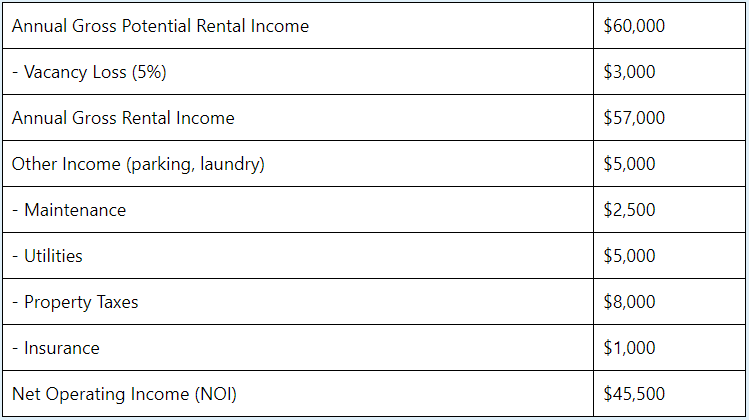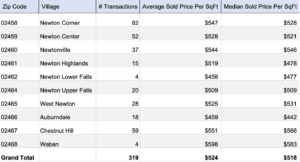Once an investor has narrowed in on a sub-market, they can begin comparing individual, like-kind properties. These sub-market analyses take a significant amount of time, and to do correctly require MLS data exports, Excel real estate models, and conversations with savvy real estate agents.
Below we provide 5 formulas you should include in your real estate analysis and detail how they are calculated and used to develop conviction.
Gross Rent Multiplier (GRM)
The GRM is calculated by dividing the purchase price of a property by the annual gross rental income. This formula is used to determine the value of a rental property based on the income it generates.
Gross Rent Multiplier = Property value or price / Annual gross rental income
The Gross Rental Income is all rental income generated by the property — often estimated at 95% of the Gross Potential Income — due to 5% vacancy rate assumptions.
You can estimate gross potential income by looking at historical MLS rental data for comparable property.
Example
Assume a 1 unit property rents for $5,000 per month or $60,000 per year and is on the market for $760,000

GRM = $760,000 / $57,000 = 13.33
Armed with that specific property’s GRM, you can compare the figure to other properties on the market.
Before looking at a specific property, investors may look at a specific sub-market, utilizing MLS to determine the average GRM in the area. This top-down approach is more useful, as it allows investors to screen out overpriced properties before doing too much work!
Capitalization Rate (Cap Rate)
The Cap Rate is calculated by dividing the net operating income of a property by its purchase price or value. This formula is used to determine the potential return on investment for a rental property and compare the investment to alternative investment options such as stocks or bonds.
It is a more in depth calculation as one must either know or estimate reoccurring expenses such as maintenance, property taxes, vacancy losses, and insurance to derive the net operating income.
Example

Cap Rate = NOI / Property value or price
Say the property listed is on the market for $760,000
Cap Rate = $45,500 / $760,000 = 6%
For a true back-of-napkin analysis, experienced investors use the rule of thirds to assume 33% of the gross operating income will be spent on reoccurring operating expenses. Depending on asset class risk, investors may be very happy with a 6% cap rate.
Cash-on-Cash Return
This formula calculates the annual return on investment for a rental property based on the cash invested and the cash generated from the property. It is calculated by dividing the annual cash flow by the total cash invested and commonly referred to the cash yield.
Cash-on-Cash = Annual Pre-Tax Cash Flow / Initial Cash Invested
One of the greatest benefits of real estate investing is the asset-backed leverage mortgages offer. This is comparable to margin trading in the equity market, but with significantly less risk. Cash-on-cash returns can dwarf non-leveraged ROI calculations and differentiate direct real estate investing from other forms.
Return on Investment (ROI)
ROI is common throughout finance and calculated by dividing the net profit of an investment by the cost of the investment. It is used to determine the terminal profitability of an investment.
In real estate, the calculation is dependent on your investment strategy — did you fix-and-flip, was it a long-term rental, did you pay cash or use mortgage? Real estate ROI breaks down into two formulas:
The Cost Method (resale/flip scenario)
ROI = Net gain / cost
Say you purchased a home for $100,000, rehabbed the property for $20,000 and then resold it within one year for $200,000.
ROI = ($200,000 – $120,000) / $200,000 = 40%
Out-of-Pocket Method (rental/hold scenario)
This scenario is based on the equity position.
Say you only put 20% down on the property and financed the remaining 80% with a mortgage. Your total equity position would be $20,000 + $20,000 = $40,000.
ROI = ($200,000 – $40,000) / $200,000 = 80%
The concept is the same for each investment scenario, with the difference highlighting the use of leverage. Of course, the formula can be more complex for a long-term hold where equity positions increase along with rental income.
Debt Service Coverage Ratio (DSCR)
The DSCR is calculated by dividing the net operating income of a property by the total debt service (typically just mortgage payments). This formula is used to determine a property’s ability to cover its debt obligations.
DSCR = NOI / Debt Service (includes interest and principal)
Anything less than 1 would indicate the property is unable to meet its loan obligations. When it comes to obtaining financing on investment property, lenders require a DSCR of 1.2 and often look for at least 1.25.
In Conclusion
When it’s all said and done, it’s important to understand variations in real estate formulas due to debt-financing (leverage), expense accounting, and investment strategy. By developing your understanding of these formulas you will be better prepared to screen, finance, and determine whether direct investing is worth the effort.
For those interested in a less hands-on approach, investing in REITs or joining a crowdsourcing fund like Fundrise can be a good option.






